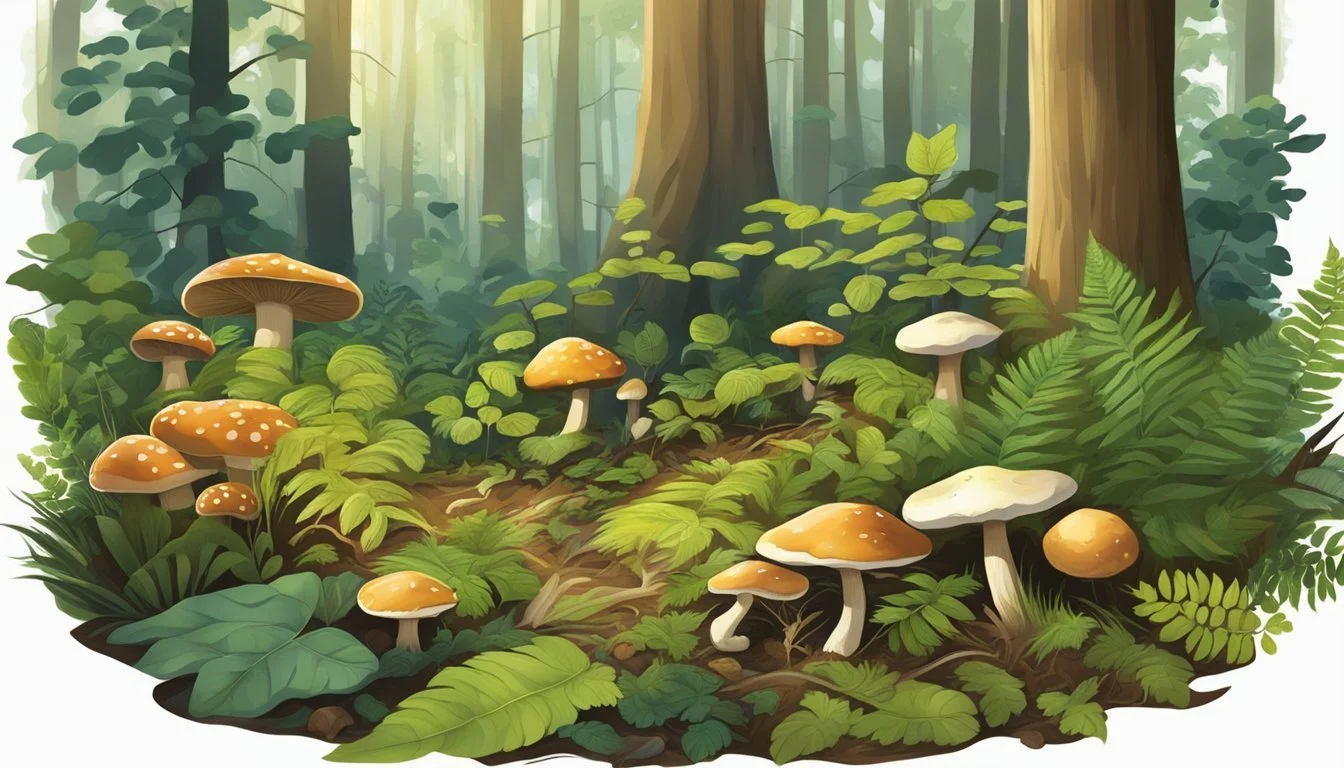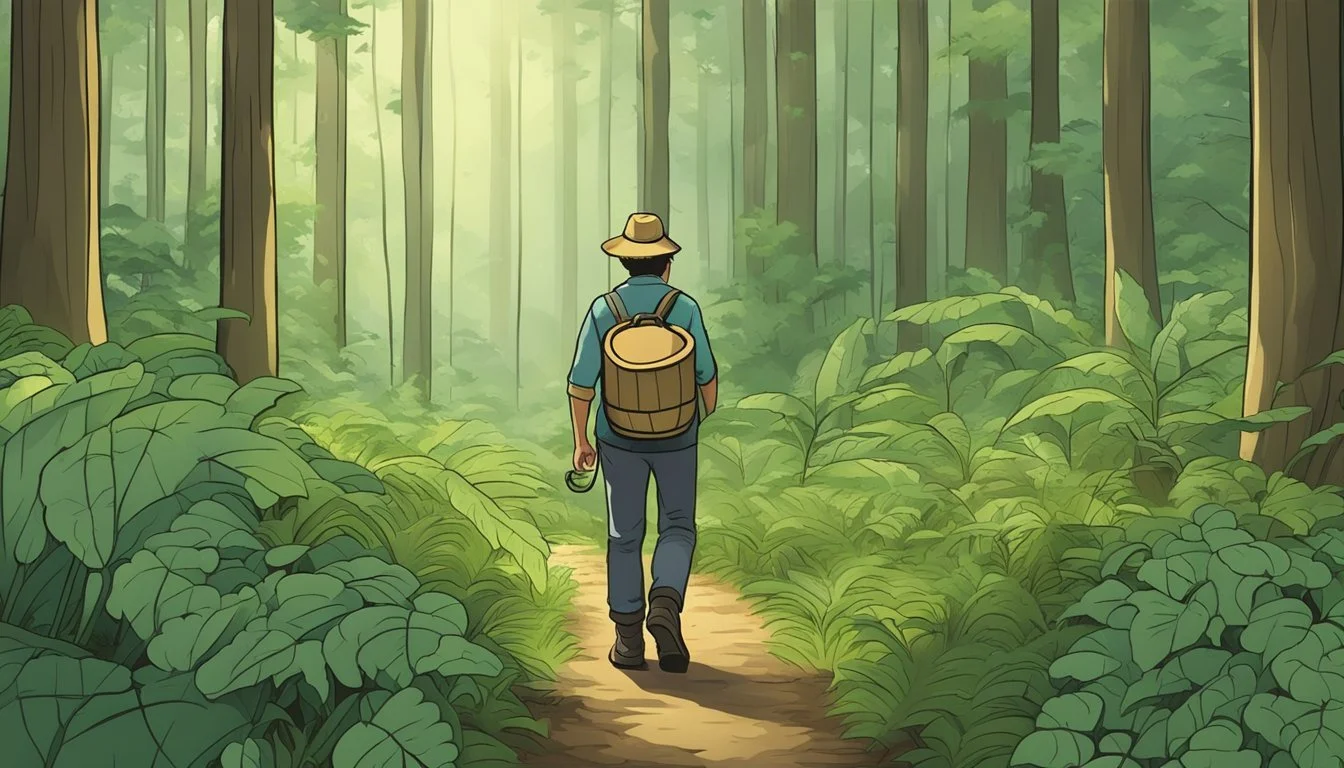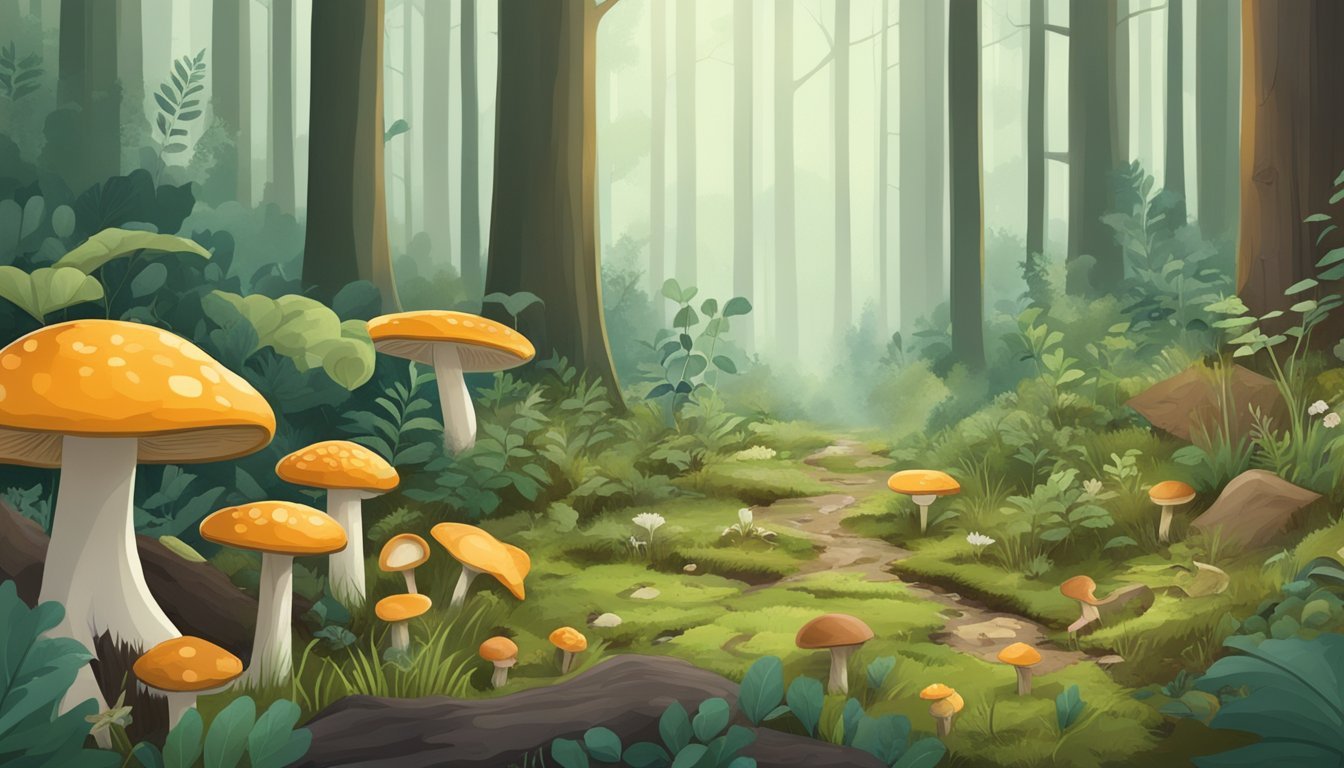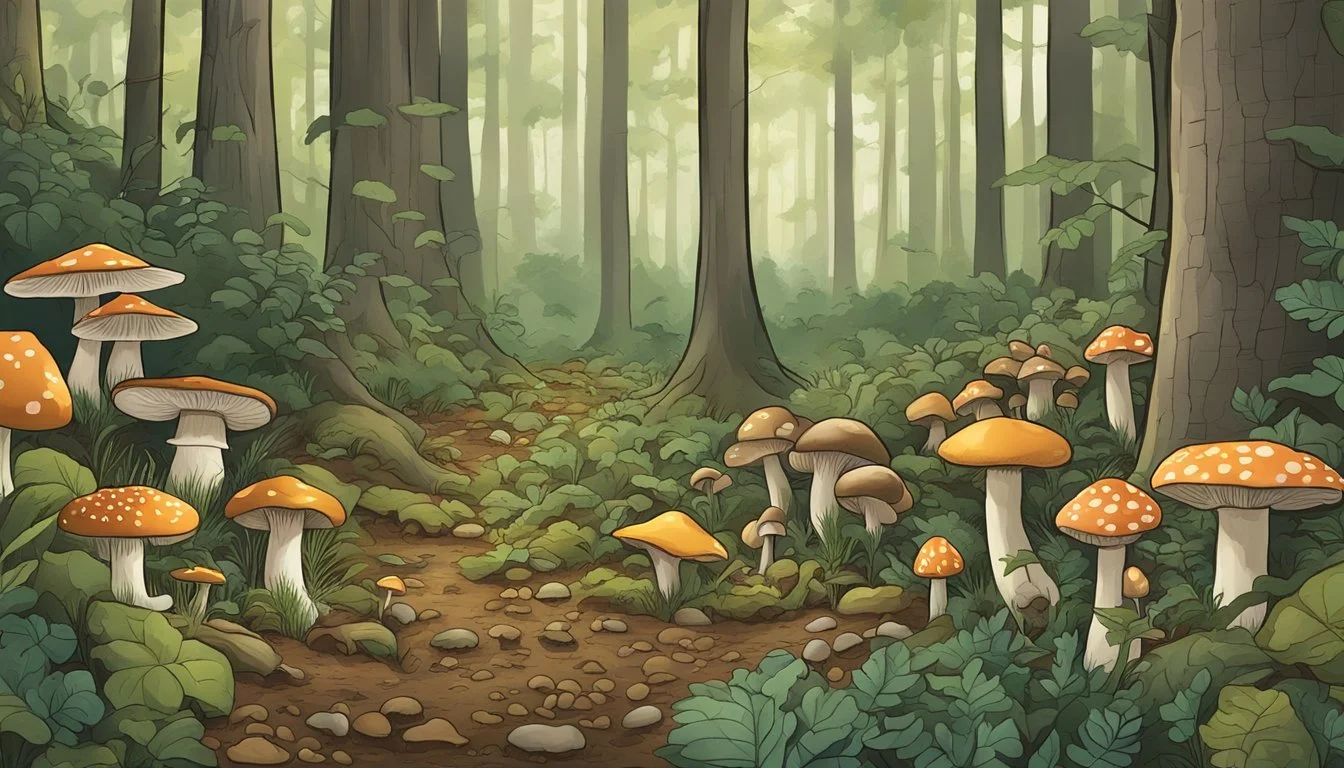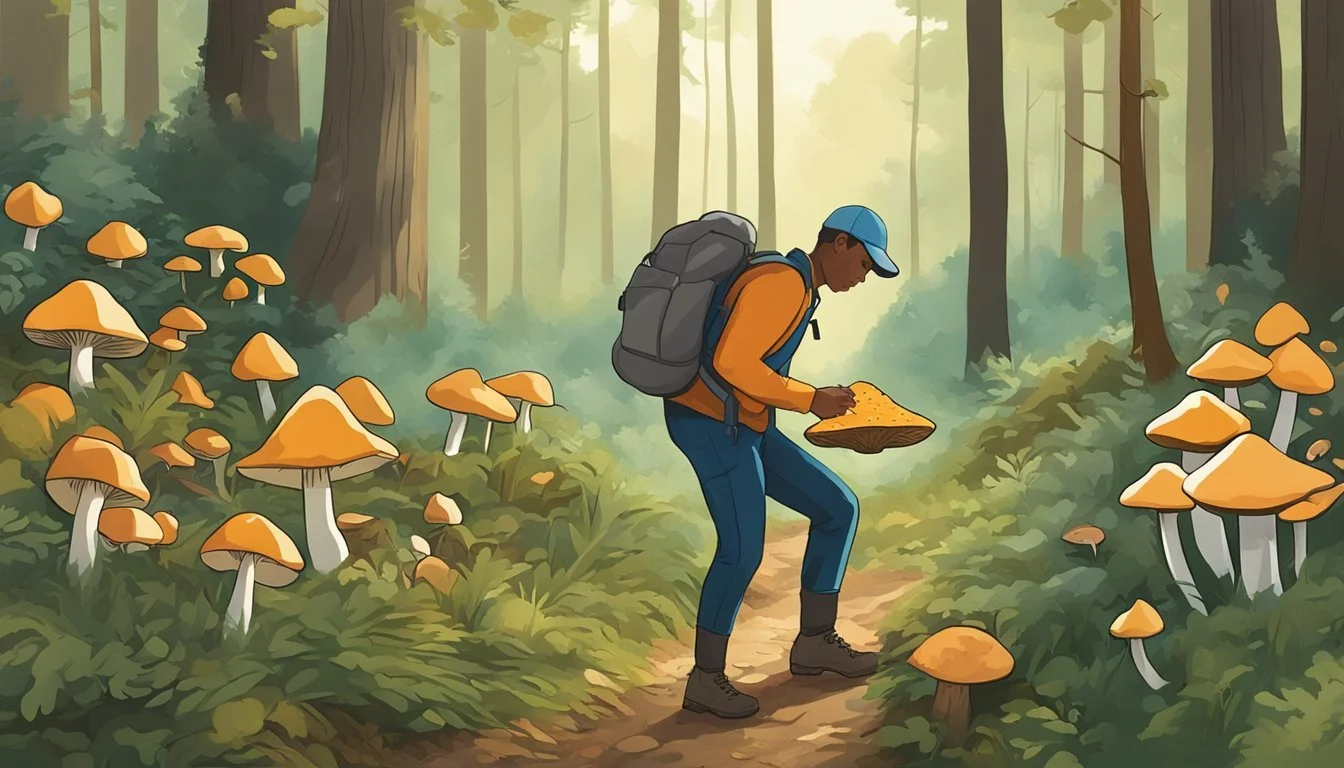Mushroom Hunting New Jersey
A Guide to Foraging Safely and Legally
This Article is Part of Our Guide on Mushroom Hunting for All 50 States
Mushroom hunting in New Jersey offers an engaging experience for nature enthusiasts and foragers alike. With a diverse range of ecosystems from the Highlands in the north to the Pine Barrens in the south, the state is home to a fascinating variety of fungi. Seasoned mycologists and amateur mushroom hunters are drawn to New Jersey's forests and fields in pursuit of both common and rare mushroom species. The activity not only connects people with nature but also provides an opportunity to learn about the local biodiversity and the ecological significance of mushrooms.
The forests and climate of New Jersey create a conducive environment for mushrooms to thrive, especially in the moist conditions of late summer and fall. Species such as Chicken-of-the-Woods, Puffballs, Wood Blewit, and Witches' Butter are among the varieties found in the state. However, successful foraging requires knowledge of mushroom identification, as some may be easily mistaken for toxic counterparts. Local mycological associations and guides offer invaluable knowledge, ensuring that enthusiasts can hunt for mushrooms safely and responsibly.
Moreover, understanding the habitat and growth conditions is crucial for a successful foraging trip. Factors such as soil pH, the presence of specific trees, and seasonal patterns play a significant role in where and when certain mushrooms may be found. For instance, the morel—a sought-after edible mushroom—typically grows in calcareous, loamy soil and is often associated with ash or aspen trees. With the right knowledge, mushroom hunting in New Jersey can be a rewarding and enriching outdoor activity.
Foraging for More Than Just Mushrooms in New Jersey
New Jersey's lush forests and coastal regions offer a wealth of wild edibles for the curious forager, extending far beyond the well-known mushrooms. The Garden State's diverse landscapes, from the Pine Barrens to the Delaware Water Gap, provide a bounty of berries, nuts, greens, and roots. Discover the joys of foraging and immerse yourself in nature's abundance in New Jersey.
👉 Foraging for Wild Edibles in New Jersey
Commonly Found Edible Mushrooms in New Jersey
New Jersey is home to several edible mushroom species. Some of the most commonly found edible mushrooms in the state include:
Morel (Morchella spp): Commonly found in New Jersey, morel mushrooms have a distinctive honeycomb appearance and are prized for their rich, earthy flavor, making them a sought-after culinary delicacy.
Chanterelle (Cantharellus spp): These golden to yellowish-orange mushrooms are often found in wooded areas in New Jersey and have a delicate, fruity aroma and a mild, peppery taste, making them a popular choice for cooking and foraging.
Hen of the Woods (Grifola frondosa): Also known as maitake, these large, frilly mushrooms grow at the base of oak trees in New Jersey and have a rich, earthy flavor and a meaty texture, making them a prized find for foragers and chefs.
Chicken of the Woods (Laetiporus sulphureus): Often found on decaying hardwood trees in New Jersey, these bright orange shelf-like mushrooms have a soft texture and a flavor reminiscent of chicken, adding a unique touch to culinary dishes.
Oyster Mushroom (Pleurotus spp): Commonly found growing on dead or dying hardwood trees in New Jersey, oyster mushrooms have a delicate flavor and a velvety texture, making them a versatile and widely used culinary ingredient.
It is essential to properly identify any mushroom before consuming it, as some species can be poisonous. Beginners should go mushroom hunting with an experienced guide or join a local mycological society to learn how to identify edible mushrooms safely.
The Fundamentals of Mushroom Hunting
Mushroom hunting in New Jersey offers a unique opportunity to explore the rich mycological diversity of the region. It requires an understanding of mushroom biology, knowledge of local species, and awareness of the best seasons for foraging.
Understanding Mushroom Biology
Mushrooms are the fruiting bodies of fungi and are composed of a cap, stem, and often have gills on the underside of the cap where spores are produced. Mushroom hunters must be able to distinguish between edible and poisonous species as visual similarities can be deceptive.
Mycological Diversity in New Jersey
New Jersey's ecosystems provide habitats for a variety of mushrooms, including prized morels and chanterelles. The New Jersey Mycological Association (NJMA) serves as a resource for enthusiasts looking to expand their knowledge about local fungi.
Common Edible Mushrooms in New Jersey Habitat Morel Near ash or aspen trees Chanterelles Moist woods with oak trees Ringless Honey (how long does honey last?) Mushroom Deciduous forests
Optimal Seasons for Mushroom Hunting
The best time for mushroom hunting varies with species:
Morels: Typically proliferate from late March to May
Chanterelles: Found during the summer and fall
Ringless Honey Mushroom: Grows from late summer to early winter
Each season brings different mushrooms to the forefront, with spring being particularly favorable for morels.
Essential Gear and Safety
In the pursuit of mushroom hunting in New Jersey, it's vital for seekers to equip themselves with the correct gear and be aware of the necessary safety precautions to differentiate between safe and poisonous species.
Gear Checklist
Mushroom hunters should include the following items in their gear:
Knives: A sharp knife is essential for cleanly cutting mushrooms from their stalks.
Baskets or Mesh Bags: These allow for convenient carrying and help spores disperse for future growth.
Field Guides: A detailed mushroom guidebook aids in accurate identification.
Mushroom Maps: These can help pinpoint productive foraging spots within New Jersey.
Compass or GPS: Essential for navigation, particularly in dense woodlands.
Protective Clothing: Long sleeves and pants protect against scratches and insect bites.
Waterproof Boots: For traversing through potentially damp areas.
First Aid Kit: For unexpected scrapes or bruises.
Safety Measures and Poisonous Species
Identifying mushrooms correctly is critical to forager's safety; some key measures include:
Consultation: Always refer to a mushroom guidebook or maps to confirm the identity of found specimens.
Expert Advice: Novice foragers should seek knowledge from experienced individuals or local mycological associations.
Toxic Species Recognition: Be aware of highly poisonous species like Galerina marginata and Amanita muscaria which are hazardous if consumed.
Canine Companions: For those foraging with dogs, ensure the animals are supervised and trained not to consume mushrooms, as some species can be toxic to pets.
Hunters must be cautious, as some mushrooms are deceptive; thorough identification is imperative before any are deemed consumable.
Identifying Prime Mushroom Locations
To forage effectively for wild mushrooms in New Jersey, enthusiasts should familiarize themselves with the ideal habitats and host trees. Gaining knowledge about local environments leverages your harvest success.
Ideal Habitats and Host Trees
In New Jersey, mushrooms flourish in diverse habitats where the right conditions of soil and wood host types are present. Deciduous forests with oak, ash, and aspen trees are prime locations for mushrooms like the ringless honey and morels. Typically, mushrooms prefer loamy soil that is calcareous with a pH level above 6. Foragers should search around tree stumps and dead trunks, as these can be hotspots for fungal growth.
Oak Tree Stumps/Trunks: Favored by Ringless Honey Mushrooms.
Ash or Aspen Trees: Morels often associate with these species.
Foraging in New Jersey's Unique Environments
The topography and varied environmental conditions of New Jersey create distinctive foraging opportunities. The Pine Barrens offer a unique ecosystem with acidic sandy soils and a proliferation of pine trees, which can support different species of fungi. In the southern reaches, Cape May's combination of altitude, aspect, and coastal woodlands offers a different array of species. Foragers should respect the delicate balance of these environments by only harvesting what they can positively identify and need.
Sourcing Edible Mushrooms
Mushroom hunting in New Jersey offers a bounty of edible species for foragers who know where and when to look. Knowledge of local species and their growth conditions is essential for a successful harvest.
Finding and Harvesting Edible Species
Foragers seeking edible mushrooms such as morels, chanterelles, and puffballs will find that New Jersey's diverse habitats provide ample opportunity. Morels often appear in spring, identifiable by their distinctive honeycomb pattern. The sought-after chicken-of-the-woods boasts a bright orange or yellow coloring, while puffballs can be recognized by their globe-like shape and need to be harvested when their interior is white.
Mushroom Type Description Habitat Suggestion Morel Honeycomb cap, appears in spring. Near ash or aspen trees, calcareous and loamy soil. Chanterelle Yellow to orange coloring, vase-shaped. In woods, preferring moist conditions. Wood Blewit Purple to blue cap. Mixed woods amongst leaf litter. Chicken-of-the-Woods Bright orange or yellow, shelf-like. Deciduous trees, commonly oak. Witches’ Butter Jelly-like, golden-yellow. Decaying wood. Puffballs Globe-like shape, white inside when fresh and edible. Open woods, grasslands.
It's important to always positively identify mushrooms before consuming, as some edible species have toxic look-alikes.
Recognizing Seasons and Growth Conditions
Different edible mushrooms in New Jersey flourish under specific conditions. Morels, for instance, thrive in warmer weather from late March to May. These mushrooms prefer slightly alkaline soil with a pH above 6. Chanterelles require higher humidity and are typically found amidst the leaf litter of hardwood forests, often after rain.
Growth conditions to pay attention to include:
Acidity: The pH level of the soil can influence where certain mushrooms grow.
Specific conditions: Factors such as moisture, temperature, and surrounding flora are critical.
Rain: A crucial element, as many mushrooms need wet conditions to develop properly.
By understanding these conditions, foragers can time their search to optimize their chance of a successful harvest.
Ethical and Sustainable Foraging
When engaging in mushroom hunting in New Jersey, foragers should prioritize sustainable practices and ethical considerations. Sustainability ensures that mushroom populations thrive for future generations, and adhering to ethical foraging guidelines helps protect natural habitats.
Accurate Identification:
Essential for Safety: Foragers must be able to identify edible species accurately.
Prevents Harm: Mistaking toxic mushrooms for edible ones can have grave consequences.
Responsible Harvesting Practices:
Take Only What You Need: Foragers are encouraged to harvest in moderation.
Leave Some Behind: Allow for natural propagation by not over-harvesting mushrooms.
Impact on Ecosystem:
Avoid Disturbance: Foragers should minimize their impact on the environment, preserving the surrounding flora and fauna.
Contribute to Conservation: Picking mushrooms should be done in a way that doesn't harm their mycelium— the underlying fungal network essential for their growth.
Folklore vs Fact:
Disregard local myths that suggest unsustainable methods.
Rely on current, evidence-based practices that support long-term ecological health.
Legal Considerations:
Foragers must adhere to local laws and regulations concerning foraging.
Some areas may be protected or have restrictions on mushroom gathering.
By respecting these principles, foragers act as stewards of the environment, ensuring a balance between enjoying nature's bounty and preserving it. This conscious approach supports the longevity of mushroom populations and their ecosystems.
Local Mycology and Community
In New Jersey, mushroom hunting is a popular and educational pastime, with organizations such as the New Jersey Mycological Association (NJMA) at the forefront of fostering a community of enthusiasts. The state's diverse ecosystems, from the Pine Barrens to coastal regions, make it an ideal location for mycological exploration and community events.
New Jersey Mycological Association (NJMA)
The NJMA is the heart of the mushrooming community in the Garden State. With members primarily from New Jersey, Pennsylvania, and New York, the association has established itself as a beacon for those interested in fungi. The NJMA conducts regular forays into various ecosystems, ranging from Ringwood to the Pine Barrens and down to Cape May, providing opportunities for mushroom hunters to explore and learn.
Community Events and Forays
The association is prominent for its education-centric events and forays, where both novice and experienced mycologists gather. Throughout the warm and wet seasons, from May to October, the NJMA organizes weekly excursions, inviting the community to partake in the fun of fungi hunting. These events take place at different state parks and wooded areas, ensuring a diverse experience for all attendees.
Weekly Forays: Engagement with diverse ecosystems
Community Events: Education and mushroom identification workshops
Contribution to Science and Education
The NJMA plays a pivotal role in advancing mycological knowledge and contributing to scientific research in the region. By conducting forays that double as field research, the NJMA provides valuable data on local fungal biodiversity. The association also contributes to the education of the public, aiding in the understanding and appreciation of New Jersey's rich mycological landscape.
Scientific Research: Data collection on fungal biodiversity
Public Education: Workshops and resources for better understanding of mycology
Through these subsections, it is evident that New Jersey's local mycology and community are robust and inviting, presenting an array of opportunities for both the amateur and veteran mushroom hunters to engage, learn, and contribute to the wider appreciation and scientific understanding of fungi.
Advancing Your Mushroom Hunting Skills
In New Jersey, mushroom hunters can elevate their foraging proficiency by honing their identification acumen and utilizing a range of digital tools and resources.
Developing Expert Identification Skills
To become adept at mushroom hunting, one must develop expertise in distinguishing between various fungi. This involves a detailed understanding of mushroom morphology—from cap shape to gill structure. For instance, oyster mushrooms are recognized by their fan-shaped caps and decurrent gills, whereas the lion’s mane is notable for its unique, shaggy appearance. When seeking the coveted morel mushroom, hunters look for its distinctive honeycomb-like cap.
Key identification markers to consider include:
Taste and Color: While taste should only be used as identification by experienced foragers due to potential risks, color serves as a vital primary indicator. A Ringless Honey Mushroom presents with a honey-colored cap, for example.
Size: Size can vary significantly within a species, but understanding typical size ranges is crucial for accurate identification.
Mushroom hunters should also consult mushroom guidebooks specific to New Jersey, which provide a wealth of localized information about edible varieties and their lookalikes.
Using Technology and Resources
Technology, such as specialized mushroom maps, can guide one to areas where certain species are likely to grow. They take into account factors like seasonality and regional flora, offering an informed starting point for foraging trips.
For more structured learning, one can utilize:
Mushroom Hunting Applications: Mobile apps provide field resources and identification tools at one’s fingertips.
Online Forums and Local Clubs: Organizations like the New Jersey Mycological Association encourage knowledge sharing amongst fungi enthusiasts, which can be crucial for skill advancement.
By dedicating time to study and employing various resources, one can significantly improve their proficiency in the art of mushroom hunting.
Mushroom Hunting Regulations in New Jersey
In New Jersey, mushroom foragers should adhere to a set of regulations designed to ensure sustainability and safety. While the state, commonly known as the Garden State, offers a range of locales for mushroom hunting, it is essential for foragers to understand the legal framework.
Permit Requirements:
State Parks: Foragers may require a permit to collect mushrooms in certain state parks. It is imperative to check with park officials prior to foraging.
Private Property: Permission must be obtained from landowners before foraging on private land.
Quantity Limits:
Collecting mushrooms in limited quantities is advised to avoid disrupting the ecosystem. Foragers should only take what they intend to use.
Protected Areas:
Some areas may be under conservation or have restrictions to protect native flora and fauna. Mushroom foragers must respect these restrictions.
Safety Regulations:
Foragers should be well-versed in identifying both edible and poisonous mushrooms to prevent accidental poisoning. Taking a field guide or consulting with local mycological associations can be beneficial.
Consuming wild mushrooms without proper identification is highly discouraged.
Environmental Considerations:
Foragers should not disturb the surrounding area. This includes minimizing soil disruption and avoiding damage to mushroom mycelium.
By following these regulations, foragers can enjoy the pastime of mushroom hunting in New Jersey responsibly. Always remember that regulations can change, and it is a forager's responsibility to stay informed about the current laws.
Culinary Delights and Recipes
In the forests of New Jersey, foragers can uncover a variety of mushrooms that are not only safe to eat but also offer a range of delightful flavors. A few edible types include the Aborting Entoloma, Chicken-of-the-Woods, and Ringless Honey Mushroom.
One can prepare Lions Mane Crab (What wine goes well with crab?) Cakes, infusing the dish with the delicate, seafood-like flavors of Lion's Mane mushrooms. This species is applauded for its meaty texture providing a vegetarian alternative to crab meat.
Maitake and Porcini Stew is another hearty option, where the earthiness of Porcini and the rich, savory taste of Maitake create a comforting dish. For a simple appetizer, one might select Stuffed Mushrooms, utilizing the versatile Cremini as a base, and a "sausage" made from finely chopped, seasoned mushrooms.
Below is a brief, illustrative table of recipes and their key mushroom ingredients:
Recipe Key Mushroom Ingredient Lions Mane Crab Cakes (What wine goes well with crab cakes?) Lions Mane Mushroom Mushroom Gratin Choice of Edible Mushrooms Porcini Burgers Porcini & Cremini Mushrooms Maitake and Porcini Stew Maitake & Porcini Mushrooms Stuffed Mushrooms with Mushroom Sausage Cremini Mushrooms
Each mushroom adds a unique taste profile to the dish. The Chicken-of-the-Woods stands out for its chicken-like flavor, hence the name. These culinary delights showcase the versatility and exquisite taste that New Jersey's edible mushrooms contribute to various recipes.
Mushroom Hunting Challenges and Stories
In New Jersey, mushroom hunters embark on an adventure that promises both fun and the thrill of discovery. The experience often comes with its own set of challenges, and for many seasoned foragers, each find is a story worth sharing.
Personal Stories from Seasoned Foragers
Many foragers in New Jersey recount times when finding the elusive morel mushroom felt like a treasure hunt. One local forager tells of a particular spring morning when, after hours of searching through moist soil and decaying wood, she uncovered a sizeable patch of morels. The excitement in her voice is palpable as she recalls the moment she knew her patience had paid off handsomely.
Others in the foraging community share stories of gatherings, like the mushroom hunt—or foray—where novices and experts alike share their fascination for fungi. Tales of family outings in search of the Ringless Honey Mushroom and other native species, illustrate how such common pursuits can create lasting memories and foster a deep appreciation for New Jersey's natural offerings.
Overcoming Common Obstacles
Foragers often encounter several obstacles during their hunts, but learning how to overcome them is part of the experience. The common challenges include:
Identifying Edible Species: Ensuring the correct identification of edible mushrooms versus their toxic counterparts is paramount for every forager’s safety.
Solution: Joining local associations such as the New Jersey Mycological Association offers education and resources on mushroom identification.
A Changing Environment: Seasonal weather patterns affect the growth and size of mushroom yields.
Solution: Mushroom hunters learn to adapt by understanding the optimal seasons and environmental conditions for various species.
Competition for Resources: As foraging grows in popularity, the competition for mushrooms, especially morels, increases.
Solution: Experienced foragers recommend exploring less trafficked areas and sharing locations only with trusted fellow mushroom enthusiasts.
Through these personal accounts and shared challenges, the community of mushroom hunters in New Jersey continues to thrive, offering both the novice and the seasoned forager invaluable experiences in the wild.
Appendix
When embarking on mushroom hunting in New Jersey, it's essential for foragers to have quick access to resources that ensure a safe and rewarding experience. Below is a collection of resources and tips that one may find useful.
Recommended Gear for Mushroom Foraging:
Field Guide: A comprehensive field guide is indispensable for identification.
Basket or Mesh Bag: To carry your finds and allow spores to disperse.
Knife: A small knife helps to harvest mushrooms without damaging their mycelium.
Common Edible Mushrooms:
Laetiporus sp. (Chicken-of-the-Woods)
Lycoperdon perlatum (Gem-studded Puffball)
Armillaria tabescens (Ringless Honey Mushroom)
Seasonal Availability:
Mushroom Type Spring Summer Fall Winter Chicken-of-the-Woods ✓ ✓ Gem-studded Puffball ✓ Ringless Honey Mushroom ✓
Safety Precautions: Always cross-reference mushrooms with multiple sources before consuming. Never rely solely on visual identification, as some edible mushrooms have toxic look-alikes.
Local Expertise:
For those seeking guidance, the New Jersey Mycological Association offers a wealth of local knowledge. They organize events and forays which can be valuable for both beginners and experienced foragers.
Remember that mushroom foraging requires responsibility and respect for the environment. Always adhere to local regulations and practice sustainable harvesting by only taking what you need and leaving the habitat undisturbed for future growth.
References
For those seeking comprehensive information on mushroom hunting in New Jersey, a variety of resources are available. Enthusiasts can refer to several key publications and organizations that cater to mycology, the study of fungi. Below is a list of vetted references that provide reliable insights into the thriving New Jersey mushroom foraging scene:
New Jersey Mycological Association: As the principal mushroom club in New Jersey, NJMA is a treasure trove of local fungal knowledge, offering records spanning from 1981 to 2019. Their expertise covers a range from Ringwood to the Pine Barrens and Cape May. More information can be found on their official website.
"Common Fungi of New Jersey": This compilation provides detailed records and descriptions of local fungi, serving as a valuable guide for both novices and seasoned foragers.
Mushroom Hunting Guides: Various online guides and articles offer valuable tips on mushroom foraging. These resources often include:
Descriptions of common edible mushrooms such as the Ringless Honey Mushroom (Armillaria Tabescens) and the Chicken-of-the-Woods (Laetiporus sp.).
Visual aids for mushroom identification.
Safety tips and best practices for sustainable foraging.
Locations and maps highlighting fruitful mushroom spots across the state.
Foragers are strongly encouraged to consult multiple sources and cross-reference information to ensure accuracy and safety when hunting for mushrooms.

